
View of Centro Habana and Vedado from the Castillo De Los Tres Reyes Del Morro. (542k)
This page has pictures from various towns and cities, including different sections of various parts of Havana (Spanish: La Habana).
All pictures are © Dr. Günther Eichhorn, unless otherwise noted.
From the Wikipedia entry for Havana:
Havana (Spanish: La Habana) is the capital city, largest city, province, major port, and leading commercial center of Cuba. The city has a population of 2.1 million inhabitants, and it spans a total of 781.58 km² (301.77 square miles) – making it the largest city by area, the most populous city, and the fourth largest metropolitan area in the Caribbean region. The city extends mostly westward and southward from the bay, which is entered through a narrow inlet and which divides into three main harbors: Mari melena, Guanabacoa and Antares. The sluggish Almendares River traverses the city from south to north, entering the Straits of Florida a few miles west of the bay.
Havana was founded by the Spanish in 1519 in the natural harbor of the Bay of Havana. Due to its strategic location it served as a springboard for the Spanish conquest of the Americas, becoming a stopping point for treasure-laden Spanish galleons returning to Spain. King Philip II of Spain granted Havana the title of City in 1592. Walls as well as forts were built to protect the old city. The sinking of the U.S. battleship Maine in Havana's harbor in 1898 was the immediate cause of the Spanish–American War.
Contemporary Havana can essentially be described as three cities in one: Old Havana, Vedado and the newer suburban districts.
Old Havana and its Fortification System is a UNESCO World Heritage Site.




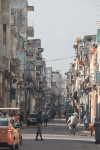
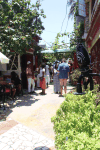
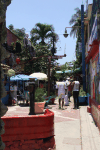




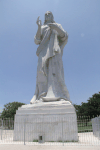
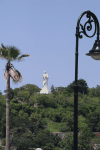


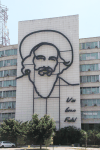
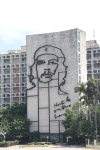

From the Wikipedia entry for Colón Cemetery, Havana:
The Colón Cemetery, or more fully in the Spanish language Cementerio de Cristóbal Colón, was founded in 1876 in the Vedado neighborhood of Havana, Cuba on top of Espada Cemetery. Named for Christopher Columbus, the 57 ha (141 acres) cemetery is noted for its many elaborately sculpted memorials. It is estimated that today the cemetery has more than 500 major mausoleums (many built by Victor Citarella), chapels, and family vaults.
Colón Cemetery is one of the most important historical cemeteries in the world and is generally held to be the most important in Latin America in historical and architectural terms, second only to La Recoleta in Buenos Aires. Prior to the opening of the Colón Cemetery, Havana's dead were laid to rest in the crypts of local church catacombs and then, beginning in 1806, at Havana's newly opened Espada Cemetery. When locals realized there would be a need for a larger space for their community's dead (due to an 1868 cholera outbreak), planning then began for the Colón Cemetery.
It was built by the Galician architect Calixto Arellano de Loira y Cardoso, a graduate of Madrid's Royal Academy of Arts of San Fernando, and who became Colón's first occupant when he died before his work was completed. Yet for all its elegance and grandeur Colón Cemetery conceals as much as it displays. Empty tombs and desecrated family chapels disfigure the stately march of Cuban family memorials even in the most prominent of the avenues, and away from the central cross-streets, ruin. Many of these are the tombs of exiled families, whose problems with caring for their dead have been complicated by residence in new countries.



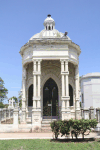

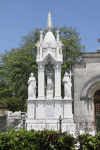





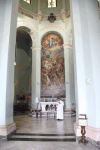
From the Wikipedia entry for Old Havana:
Old Havana (Spanish: La Habana Vieja) is the city-center (downtown) and one of the 15 municipalities (or boroughs) forming Havana, Cuba. It has the second highest population density in the city and contains the core of the original city of Havana. The positions of the original Havana city walls are the modern boundaries of Old Havana.



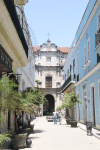
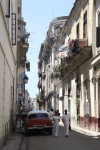
















From the Wikipedia entry for Morro Castle (Havana):
Morro Castle (Spanish: Castillo de los Tres Reyes Magos del Morro), named after the three biblical Magi, is a fortress guarding the entrance to Havana bay in Havana, Cuba. The design was drawn up by the Italian engineer Battista Antonelli; originally under the control of Spain, the fortress was captured by the British in 1762, and was returned to the Spanish under treaty terms a year later.
The Morro fortress in Havana shares its name with structures in Santiago de Cuba and the Castillo de San Felipe del Morro in San Juan, Puerto Rico. In this case, the Spanish "morro" means a rock which is very visible from the sea and therefore serves as a navigational landmark. Perched on the promontory on the opposite side of the harbor from Old Havana, it can be viewed from miles around as it dominates the port entrance. Built initially in 1589 in response to raids on Havana harbor, el Morro protected the mouth of the harbor with a chain being strung out across the water to the fort at La Punta.






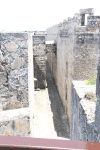
In 1975 the artist José Rodríguez Fuster converted his home in the fishing village Jaimanitas into an art museum by adoring it with tile mosaics. By now the whole neighborhood is decorated with these tile mosaics.




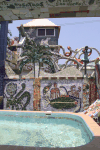

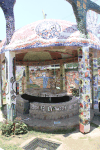
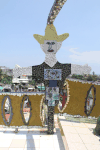
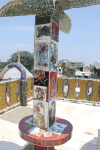


From the Wikipedia entry for Cienfuegos:
Cienfuegos, capital of Cienfuegos Province, is a city on the southern coast of Cuba. It is located about 250 km (155 miles) from Havana and has a population of 150,000. The city is dubbed La Perla del Sur (Pearl of the South). Cienfuegos literally translates to "one hundred fires"—cien meaning "one hundred", fuegos meaning "fires".
The area where the city lies was identified as Cacicazgo de Jagua by early Spanish conquistadors. It was originally settled by Taino indigenous people. Cacicazgo translates from the Taino language as "chiefdom". Cacicazgo de Jagua was therefore the chiefdom of Chief Jagua.
The city was later settled by French immigrants from Bordeaux and Louisiana led by Don Louis de Clouet on April 22, 1819. The settlers named the city Fernandina de Jagua in honor of King Ferdinand VII of Spain and Chief Jagua. The settlement successively became a town (villa) in 1829, renamed for José Cienfuegos, Captain General of Cuba (1816–19), and a city in 1880.
The Urban Historic Centre of Cienfuegos is a UNESCO World Heritage Site.











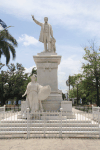



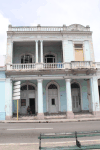




From the Wikipedia entry for Trinidad, Cuba:
Trinidad is a town in the province of Sancti Spíritus, central Cuba. It was founded on December 23, 1514 by Diego Velázquez de Cuéllar under the name Villa de la Santísima Trinidad.
Hernán Cortés recruited men for his expedition from Juan de Grijalva's home in Trinidad and Sancti Spíritus, at the start of his 1518 expedition. This included Pedro de Alvarado and his five brothers. After ten days, Cortes sailed, the alcayde Francisco Verdugo failing to prevent Cortes from leaving, despite orders from Diego Velázquez.
Francisco Iznaga, a Basque landowner in the southern portion of Cuba during the first 30 years of the colonization of Cuba, was elected Mayor of Bayamo in 1540. Iznaga was the originator of a powerful lineage which finally settled in Trinidad where the Torre Iznaga (Iznaga Tower) is. His descendants fought for the independence of Cuba and for annexation to the USA, from 1820 to 1900.
Trinidad is one of the best-preserved cities in the Caribbean from the time when the sugar trade was the main industry in the region. Its 18th- and 19th-century buildings, such as the Palacio Brunet and the Palacio Cantero, were built in its days of prosperity from the sugar trade.
Trinidad and the Valley de los Ingenios is a UNESCO World Heritage Site.






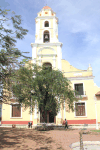


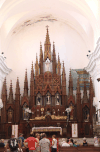






This page contains 105 pictures
Page last updated on Tue Sep 24 18:19:03 2019 (Mountain Standard Time)
Page last updated on Thu Apr 25 02:55:11 2024 (Mountain Standard Time)
Towns in Cuba on gei.geichhorn.com